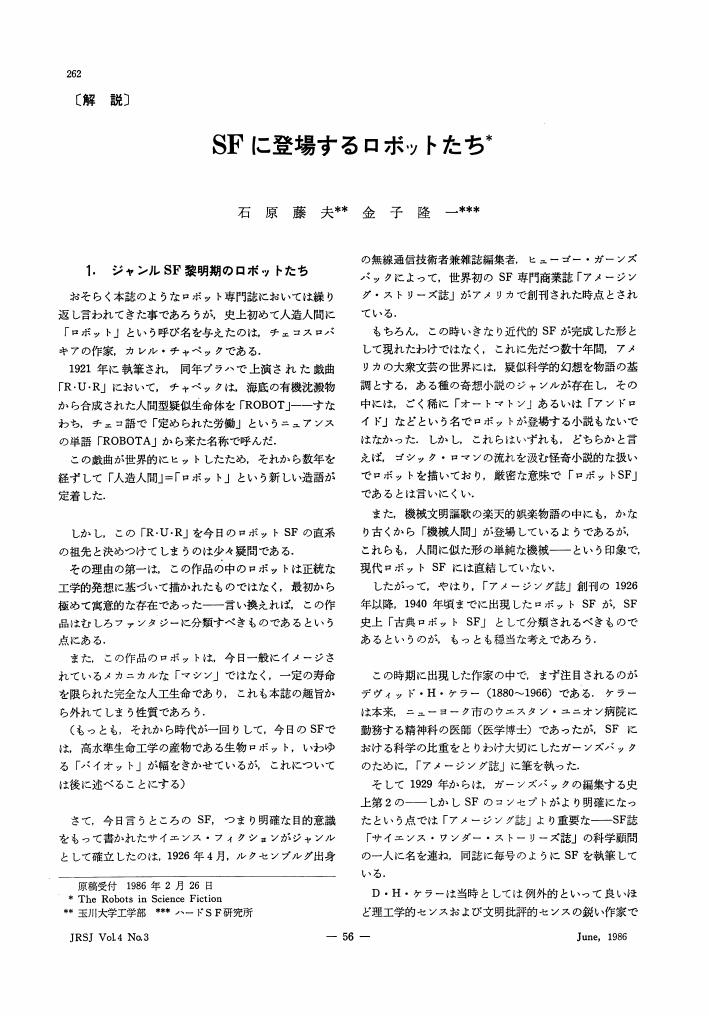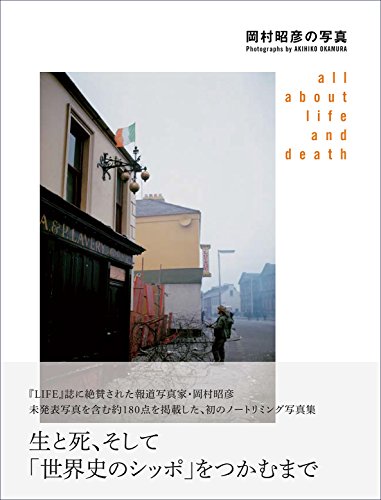17 0 0 0 OA 科学技術の予見者としてのSF その実態と機能
- 著者
- 金子 隆一
- 出版者
- 公益社団法人 計測自動制御学会
- 雑誌
- 計測と制御 (ISSN:04534662)
- 巻号頁・発行日
- vol.43, no.1, pp.2-7, 2004-01-10 (Released:2009-11-26)
4 0 0 0 OA 「ニュー・トポグラフィックス」―新しい風景写真の位置―
- 著者
- 金子 隆一
- 出版者
- 日本映像学会
- 雑誌
- 映像学 (ISSN:02860279)
- 巻号頁・発行日
- vol.35, pp.24-33, 1986-11-25 (Released:2017-06-30)
- 参考文献数
- 5
The problem at the heart of photographic expression through 1970s was essentiality of photography. “Mirrors and Windows” directed by John Szarkowski at MOMA in 1978 had a historical aspect on this problem. Two conceptions of photography – a mirror reflecting a portrait of the artist who made it and a window through which one might better know the world – show the principle of photography. There have been attempts of approach to contemporary photographic expression, one of which is “NEW PHOTOGRAPHICS” directed by William Jenkins at IMP/GHT in 1974. The photography of NEW TOPOGRAPHICS has something in common with neutral and objective attitude to the world. It must not be understood as a new trend of expression but as a tradition of American Landscape from the painters of Hudson River-school. Modern American landscape photography typified by Ansel Adams was deprived of entity in photographic description. But NEW TOPOGRAPHICS acquired new entity to return to classical landscape photography typified by Frontier Photographers like Timothy O’Sullivan. William Jenkins says, in the introduction of catalogue, that if “New Topographics” has a central purpose it is simply to postulate, at least for the time being, what it means to make a documentary photograph. NEW TOPOGRAPHICS presented an aspect of Landscape as Document.
3 0 0 0 OA SFに登場するロボットたち
- 著者
- 石原 藤夫 金子 隆一
- 出版者
- The Robotics Society of Japan
- 雑誌
- 日本ロボット学会誌 (ISSN:02891824)
- 巻号頁・発行日
- vol.4, no.3, pp.262-267, 1986-06-15 (Released:2010-08-25)
2 0 0 0 OA 人口統計学の展開
- 著者
- 金子 隆一
- 出版者
- 一般社団法人日本統計学会
- 雑誌
- 日本統計学会誌 (ISSN:03895602)
- 巻号頁・発行日
- vol.31, no.3, pp.345-377, 2001-12
1 0 0 0 OA わが国近年の出生率反転の要因について : 出生率推計モデルを用いた期間効果分析
- 著者
- 金子隆一
- 出版者
- 国立社会保障・人口問題研究所
- 雑誌
- 人口問題研究
- 巻号頁・発行日
- vol.66(2), no.273, 2010-06-25
- 著者
- 金子隆一 藤村里美 戸田昌子編集 ザ・ワード・ワークス翻訳
- 出版者
- 美術出版社
- 巻号頁・発行日
- 2014
1 0 0 0 OA 伊奈信男の写真史観 (日本映像学会第十一回大会研究発表)
- 著者
- 金子 隆一
- 出版者
- 日本映像学会
- 雑誌
- 映像学 (ISSN:02860279)
- 巻号頁・発行日
- vol.33, pp.28-31, 1986-01-31 (Released:2017-06-30)
- 参考文献数
- 7
Nobuo Ina (1898-1978) wrote “Return To Photography”(1932) that was his first article on photography.He introduced New German Photography Theories – “Neue Sachlichkeit”, “Reportage-Photo”, “Bauhaus” and others into Japan. They gave photography new concepts; “Real - Photography”, “Photography as Documents and Report of life”, “Photography as Light Plastic”.Ina added another concept; “Photographer as Social Being”. This article also discussed a historical vision on modern photography. His point of view was always focused on the active relation of photography to society.After World War II Nobuo Ina wrote several articles on the history of photography. “Establishment of Modern Photography and its Evolution” was published serially from 1964 to 1968 in which he opposed Beaumont Newhall’s and Helmut Gernsheim’s historical visions on modern photography. He believed that the true origin of modern photography was in Germany.Ina positioned Japanese photography in the History of World Photography from this point of view.
1 0 0 0 OA 結婚・離婚・再婚の動向と日本社会の変容に関する包括的研究
- 著者
- 岩澤 美帆 別府 志海 玉置 えみ 釜野 さおり 金子 隆一 是川 夕 石井 太 余田 翔平 福田 節也 鎌田 健司 新谷 由里子 中村 真理子 西 文彦 工藤 豪 レイモ ジェームズ エカテリーナ ヘルトーグ 永瀬 伸子 加藤 彰彦 茂木 暁 佐藤 龍三郎 森田 理仁 茂木 良平
- 出版者
- 国立社会保障・人口問題研究所
- 雑誌
- 基盤研究(A)
- 巻号頁・発行日
- 2013-04-01
結婚の形成と解消の変化を理解するために、(1)変化・差異の記述、(2)説明モデルの構築と検証、(3)変化の帰結の把握に取り組んだ。横断調査、縦断調査データの分析のほか、地方自治体に対するヒアリング調査を行った。若い世代ほど結婚が起こりにくく、離婚が起こりやすい背景には近代社会を生きる上で必要な親密性基盤と経済基盤という両要件が揃わない事情が明らかになった。要因には地域の生活圏における男女人口のアンバランスや縁組み制度の衰退、強すぎる関係、男女非対称なシステムと今日の社会経済状況とのミスマッチが指摘できる。一方で都市部や高学歴層におけるカップル形成のアドバンテージの強化も確認された。



